BALI PENGLIPURAN VILLAGE
BALI PENGLIPURAN VILLAGE IS TRADITIONAL BALI VILLAGE, WHICH IS UNTOUCHABLE BY THE MODERNIZATION ERA
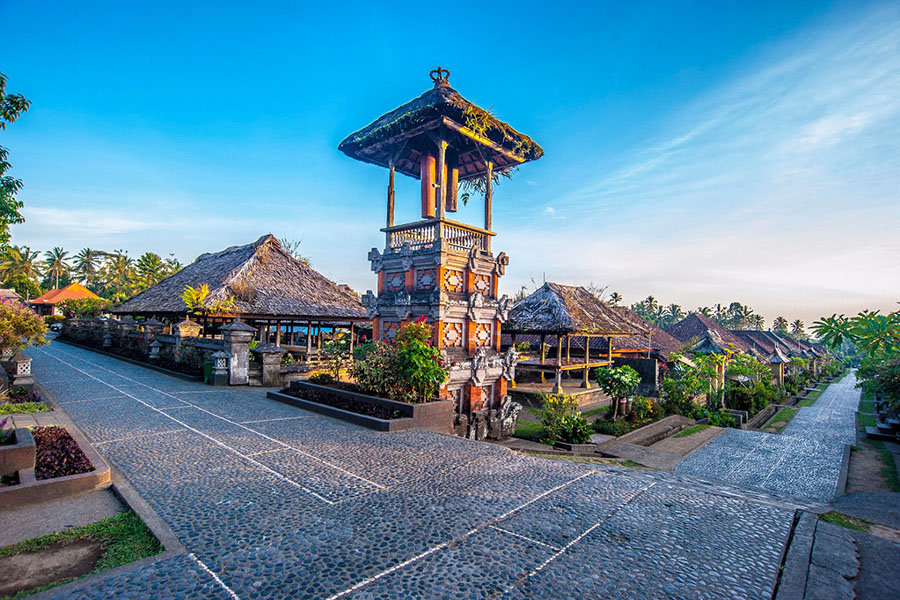
Bali Penglipuran Village, as the world’s recognized cleanest village in the world, located about 6 kilometers from Bangli or only 1 kilometer from Kubu Village, has a population of about 700 people based on the last census in 1999, with 192 households. The village is known as a traditional village that has its own characteristics and is located in the Kubu District and Bangli Regency. The beauty of the village and its environment make Penglipuran as a place that has not been affected by modernization. The fresh air at 700 meters above sea level provides a comfortable atmosphere for residents and visitors. The village still maintains the old culture and customs, with buildings that are almost the same and not influenced by modern architecture. Visiting Penglipuran village provides a pleasant experience, making you feel the atmosphere of the past that is well preserved through the preservation of its traditional houses.
If you visit Penglipuran Village, here’s what you need to know:
- Penglipuran Cultural Tourism Site
- Location of Penglipuran Village
- Topography of Penglipuran Village
- Penglipuran Village Geography
- Penglipuran Village History
- Culture Village of Penglipuran
- Facilities at Penglipuran Village
Penglipuran Cultural Tourism Site
Penglipuran Village is unique in that the beauty of the countryside has been preserved as it was in the past, without being affected by modern buildings. When you visit this village, you can see houses with the original shapes of the past that are still well preserved. Penglipuran Traditional Village features typical traditional village structures that reflect the natural beauty of the countryside. The layout of the village reflects a distinctive hereditary culture. Penglipuran Traditional Village has become a Bangli places of interest as an attractive cultural tourism destination. The beauty of the village is felt from the moment one enters the pre-village area, with green grass on the roadside and hedgerows organized along the road, creating a cool atmosphere. Visiting Penglipuran Traditional Village is a mesmerizing experience, where the village has maintained its authenticity from the past to the present and exudes a natural beauty that is simply mesmerizing.
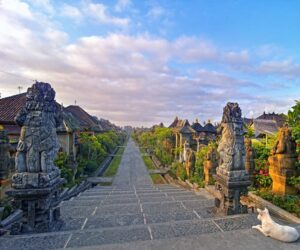
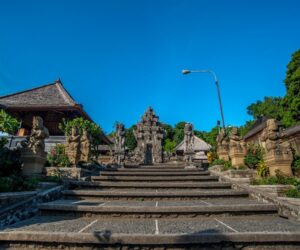
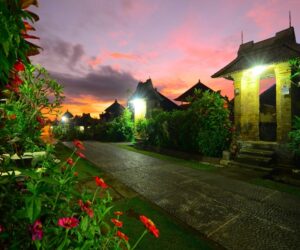
Location of Penglipuran Village
Penglipuran Village is located in Kubu Sub-district, Bangli Regency, with an area of about 112 hectares. The village is bordered by Kubu Traditional Village to the east, Gunaksa Traditional Village to the south, Tukad Sang-Sang to the west, and Kayang Traditional Village to the north. Its strategic location at the foot of Mount Batur, reaching an altitude of 700 meters above sea level, makes Penglipuran have stunning natural scenery. As one of the tourist destinations in Kintamani, this village is about 45 kilometers, or about 2 hours, from Denpasar city center. To facilitate the trip, you can use Google Maps as a guide, or if you want to be more comfortable, you can use the Bali Car Charter service from Bali Driver Hire with affordable prices and satisfying service, making your trip more enjoyable.
Topography of Penglipuran Village
The topography of Penglipuran Village is unique in that almost all of its buildings have similar shapes. The topographical design of the village is carefully arranged, where the main area of the village is placed higher, while the other areas progressively decrease to the downstream area. In the center of the village, there are Penataran Temple and Puseh Temple, which are the centers of activities and have unique characteristics. The village corridor road is reserved for pedestrians only and is flanked by village structural attributes such as pengengker walls, angkul-angkul, and uniform tejakan on either side of the road. The uniqueness in the uniformity of the face and topographic design of Penglipuran Village is very visible, especially from the similarity of building forms that are almost identical throughout the village.
The uniformity in Penglipuran village design is not only limited to the shape of the buildings but also to the materials used, such as earth for the walls of the pengengker and angkul-angkul (pol-polan), as well as split bamboo for the roofs of all village buildings. The use of bamboo as a construction material is a must, as the village is surrounded by bamboo forests that are still part of Penglipuran Village and still maintain the tradition of using bamboo in local architecture. A harmonious home atmosphere is felt when entering the village, where we seem to go back in time, seeing the ancient houses that are uniform in both design and building materials used.
Penglipuran Village Geography
The villages surrounding Penglipuran Village are Khayan Village, Gunaksa Village, Kubu Village, and Ceking Village. Although it consists of several small villages, administrative adjustment is not difficult because the numbers are balanced. The name “Penglipuran Village”, according to a myth believed by its inhabitants, comes from “Pengeling Pura”, which means remembering the temple, referring to their respect for their ancestors. This myth is related to the migration of ancestors from Bayung Gede village in the Kintamani region to Penglipuran village. As a form of respect to the ancestors in Bayung Gede, the same temples were built in Penglipuran Village, such as Bale Agung Temple, Puseh Temple, Dalem Temple, and Dukuh Temple. Until now, the four temples have been maintained and respected by the villagers as a form of ownership and respect for their ancestors.
Penglipuran Village History
According to the story of Penglipuran Village’s history, in the past in the Bangli Kingdom, when there was a war and the King of Bangli instructed the villagers of Bayung Gede to join the war and perform other tasks in the kingdom, because of the distance of Bayung Village, the King of Bangli gave them land in what is now Penglipuran Village. This was so that the Bayung Gede villagers could easily come to the king whenever needed. At first, the village was called “Kubu Bayung” in the inscription, which means Pondok Bayung Gede. Over time, the villagers built a village in this place by presenting three main temples, or Kahyangan Tiga Temple (Puseh Temple, Dalem Temple, and Desa Temple/Balai Agung), as well as other temples similar to the existing temples in Bayung Gede Village (Dang Khayangan). This is done as a form of respect for the temple in Bayung Gede Village (Ngelingang Temple in Bayung Gede Village).
In stories from community leaders in Penglipuran Village, there are several versions that explain the meaning of the word “Penglipuran”. Etymologically, the word can be interpreted as follows:
- Penglipuran village comes from the words “pangeling” and “pura”, which form the word “penglipuran”. This indicates that the people of Penglipuran built a temple similar to the one in Bayung Gede as a tribute to that temple and in memory of their ancestors.
- The origin of the word Penglipuran comes from “pelipur” and “lara”, resulting in the word “penglipuran”. This suggests that Penglipuran became a place of solace or comfort when people were grieving (lara). In addition, people often comforted the king when he faced difficulties.
- The word Penglipuran comes from “pangleng” and “pura”, forming the word “penglipuran”, which describes that anyone visiting Penglipuran will pass by temples located in all four cardinal directions: north, east, south, and west. In other words, Penglipuran is surrounded by temples.
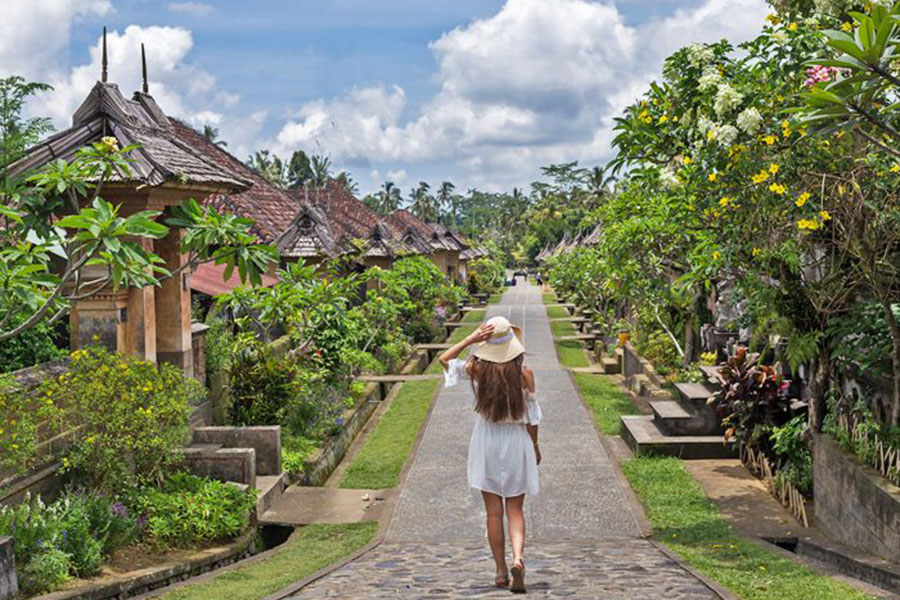
Culture Village of Penglipuran
In 1993, the government officially designated Penglipuran Village as one of the tourist destinations on Bali Island, with Bangli Regent Decree number 115 dated April 29, 1993. Penglipuran Village applies strict customary rules to maintain sustainability as a tourist village. One of the restrictions imposed is the prohibition of using motorized vehicles in order to maintain clean air. Although for first-time tourists this rule may seem surprising, once they enter the village, they will feel the fresh air with minimal pollution and a variety of colorful plants. The traditional architecture in Penglipuran Village is also similarly characterized and well-organized, starting from the taller main buildings and getting lower to the lower part of the village. Balinese gates (angkul-angkul) are used as access to the houses, which look uniform in every courtyard. The doors of the houses face each other and are separated from the main street of the village, thus creating an organized order. Other customary rules include a ban on polygamous marriages, an emphasis on the Sudra caste, and dance customs that are passed down through generations, such as the Baris Dance.
Facilities at Penglipuran Village
Penglipuran Village is one of the cultural tourism destinations famous for its local wisdom and the beauty of its well-maintained customs, so it is always crowded with tourists who are interested in the houses and yards that retain the classic design from ancient times. When visiting Penglipuran Village, you will feel the sensation of being in the past with the unique and beautiful ancient buildings around it. The facilities available in Penglipuran Village are very complete. The large parking lot can accommodate many cars, so you don’t need to worry when visiting. There are also clean toilets with the concept of voluntary payment, small stalls that provide snacks and cold drinks to refresh yourself while touring the village, as well as a place to sell typical Penglipuran village crafts that can be used as souvenirs when leaving this village. All these facilities are well organized to pamper the tourists who come to Penglipuran Village.

